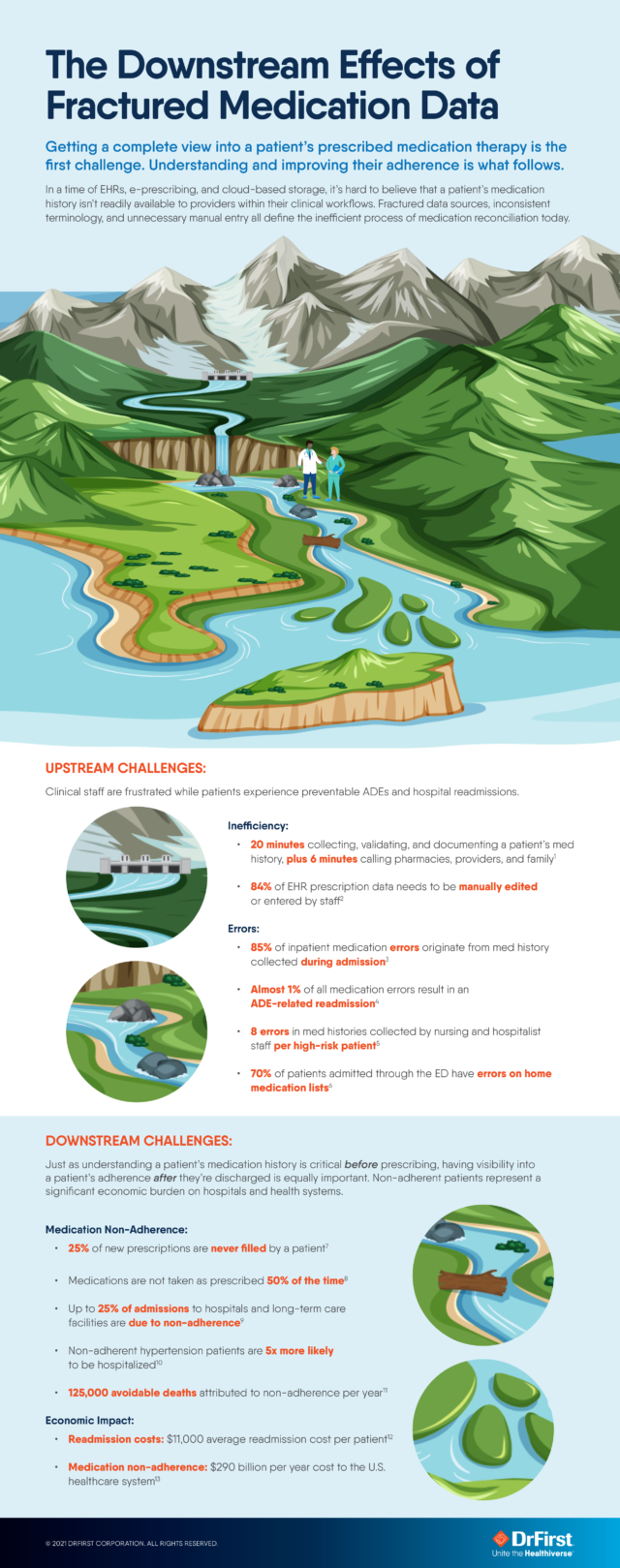Fractured Medication Data Infographic
In a time of electronic health records, e-prescribing, and cloud-based storage, it’s hard to believe that a patient’s medication history isn’t always readily available to providers within their clinical workflows. Yet fractured data from multiple sources, inconsistent terminology between different systems, and time-consuming manual entry all hinder the medication reconciliation process. Providers are frustrated, patients are at risk of preventable adverse drug events (ADEs), and hospitals are bearing responsibility for readmissions. This infographic explores how process inefficiencies and errors in the Emergency Department and at admission can jeopardize patient safety and hospital finances.

Source List:
- Results from DrFirst’s Med Rec Excellence Program where 283 individual hospital systems were surveyed
- Zheng Y, Jiang, Y, Dorsch MP, et al. Work Eort, Readability and Quality of Pharmacy Transcription of Patient Directions from Electronic Prescriptions: A Retrospective Observational Cohort Analysis. BMJ Quality & Safety 2021;30:311-319.
- Results of the Medications At Transitions and Clinical Handoffs (MATCH) Study: An Analysis of Medication Reconciliation Errors and Risk Factors at Hospital Admission found that one-third of inpatient orders contain errors, with 85% of these originating from the medication history collected during the admission process.
https://www.ncbi.nlm.nih.gov/pmc/articles/PMC2855002 - Bates DW, Boyle DL, Vander Vliet MB, Schneider J, Leape L. Relationship Between Medication Errors and Adverse Drug Events. J Gen Intern Med. 1995;10:199-205.https://pubmed.ncbi.nlm.nih.gov/7790981
- Improving admission medication reconciliation with pharmacists or pharmacy technicians in the emergency department identified that medication histories collected by nursing and hospitalist staff for high-risk patients have an average of eight medication errors by the time the patient is transitioned from the ED to inpatient care
https://qualitysafety.bmj.com/content/27/7/5128 - Unintended Medication Discrepancies at the Time of Hospital Admission notes that up to 70% of patients have errors on their medication list when admitted to the hospital through the ED, and up to 59% of these errors can cause harm.
https://pubmed.ncbi.nlm.nih.gov/15738372 - Reasons for Nonadherence to Medications,https://www.empr.com/home/news/drug-news/8-reasons-for-nonadherence-to-medications
- Why You Need to Take Your Medications as Prescribed or Instructed,https://www.fda.gov/drugs/special-features/why-you-need-take-your-medications-prescribed-or-instructed
- New England Health Institute (2001); WHO (2003), Adherence to Long Term Therapies
- American Heart Association (2014), “A Tough Pill to Swallow. Medication Adherence and Cardiovascular Disease”
- New England Journal of Medicine (Aug 4, 2005)
- Medication Reconciliation Model ROI. Society of Hospital Medicine.
https://www.hospitalmedicine.org/clinical-topics/medication-reconciliation - Annual Reviews Pharmacology and Toxicology (2019)

